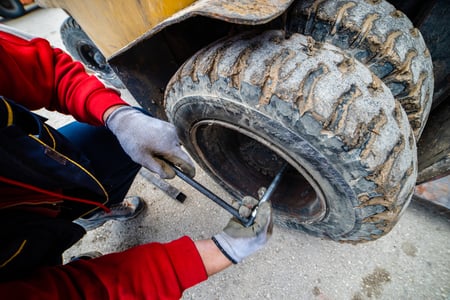 Forklift tires are the #1 maintenance cost for forklifts, with some experts estimating that forklift tires account for as much as a whopping 30% of a forklift’s operating budget.
Forklift tires are the #1 maintenance cost for forklifts, with some experts estimating that forklift tires account for as much as a whopping 30% of a forklift’s operating budget.
And the truth about those high forklift tire costs? Most of them are completely preventable.
But how do you prevent those sky-high costs? By focusing on 5 key actionable steps, facility managers can cut their #1 maintenance cost -- forklift tires -- by 80% and save thousands of dollars.
Here are 5 ways to lower your #1 cost by 80%.
1. Select the Right Tires for the ApplicationIf you’re using the wrong rubber tire or poly wheel/caster, you could be spending three times what you should on tires due to over-replacement!
This is our top-cost saving tip, so we’ll shout it from the rooftops. When we come into a facility, we usually discover that the lift tires are not appropriate for the application and end up swapping them out for another type.
While it’s also effective to lessen your lift loads and improve your floors (and we’d encourage you to take those steps, outlined below!), tire compounds are 100% within your control and will result in the most improvement.
For example, we had an automotive customer with 24/7 forklift usage with hard-driving operators. Their lift tires constantly had what can only be described as missing “chunks.” We recommended a better-suited tire. While the acquisition cost was higher, the new tires lasted 3000 hours versus 1000 hours, which paid off immediately when considered in light of the total cost of ownership impact.
2. EnvironmentThis one is simple but often overlooked. If your warehouse floors are a mess, your tires will suffer. Rough floor surfaces and transitions, uneven concrete joints, cracks in pavement or concrete, uneven or damaged dock plates -- these all can wreak havoc on your tires.
Dirt and debris can also cause problems: they build up over time and reduce the traction of forklift tires, which can create a dangerous environment.
And then there’s litter, which can cause major problems. Shrapnel, nails, and screws can obviously harm your tires, but those aren’t the only culprits. The main environmental issue is shrink wrap. It can get into the axles and damage them, or make its way into the radiator and cause a truck to overheat.
So make sure your floors are in good shape and, if you have outdoor trucks, ensure your paths are well-paved.
3. Ongoing Operator TrainingTwo types of training will make a significant impact on your bottom line: operator training and safety training. Let’s address them in turn.
- Operator training - You may think that your operators already know how to drive a truck. That’s why you hired them, right? But the question you should be asking is whether they know how to drive a truck properly. If your company is like most, abuse is a major cause of damage to your lift tires. That means you’re shelling out lots of money on a totally preventable cost. As mentioned earlier, driving too hard damages tires, but bad practices like dragging pallets damages your floor, which in turn damages your tires. It’s a vicious cycle! A combo of training and better tires can make a significant impact on your cost.
- Safety training - Any employees who operate forklifts should participate in a non-punitive, employee-led safety program that is geared around safe driving behaviors and practices. This program should allow for an environment where other drivers can encourage each other and praise safe driving practices when they notice them.
In other words, if you see something good, say something good: if a material handling operator is following a safety protocol, be sure to point that out. Say, “Hey, thanks for stopping at that intersection.” A little bit of positive reinforcement goes a long way in encouraging safe practices and, since accidents are a major cost, this will pay off monetarily, as well.
Best-in-class safety programs make safety a part of the operator meeting at the start of every shift.
There’s an old saying that you’ve probably heard: “A stitch in time saves nine.” That same wisdom applies here: to keep your forklift tire costs down, don’t wait for a problem to happen. Be proactive and keep up ongoing, preventive maintenance to forestall issues before they become bigger. This will save major money in the long run, as proactive maintenance helps prevent major component failures that can lead to everything from repair and rental costs to a reduction in your available forklift fleet.
Keep up frequent pre-shift inspections, looking for small problems that could become big if they aren’t treated early: stress cracks, tread wear, chunking, etc.
5. Use the Right Truck for the Right ApplicationIf you want to go off-roading in the mountains, you probably wouldn’t take a Prius. And if you needed to help a friend move, you’d probably use a car or a truck with some trunk space -- not a motorcycle.
In the same vein, you shouldn’t use an Orderpicker to put pallets into racking, or a Narrow Aisle Reach truck to run down a ramp into an outdoor yard. Use the right truck for the right application. Otherwise, you put unnecessary wear and tear on both the vehicle and the tire.
In summary, while there are a number of factors that lower costs, tires are the first thing we track from a cost standpoint at a new facility we manage. The wrong tires are the #1 driver of cost overruns. Getting the right tires for your application, with the help of a little data leveraged by the right partner, will save you a lot of downtime and cost headaches in the future.
Ask your service partner today why they choose the tires they use. If they don’t have a good answer that’s specific to your facility’s usage and conditions, you’re probably spending a lot more on maintenance than you need to.


 Ryan Lynch
Ryan Lynch

